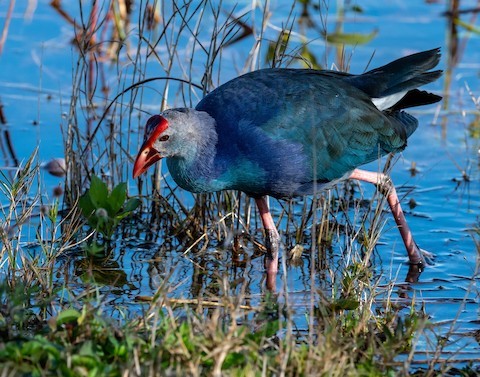Birdfinding.info ⇒ Common and widespread across much of the Indian subcontinent. More localized elsewhere, but also common across most of Thailand, Cambodia, and Florida—where introduced and abundant in Broward and Palm Beach Counties (especially at Green Cay Wetlands), and spreading. Populations vary locally in their habits: some are bold and nearly indifferent to humans while others are secretive. Most readily observed in refuges where it becomes acclimated to people.
Gray-headed Swamphen
Porphyrio poliocephalus
Southern Asia, nearly throughout the Indian subcontinent and Southeast Asia south to Sumatra, and patchily westward to central Turkey, and northeast to southern China.
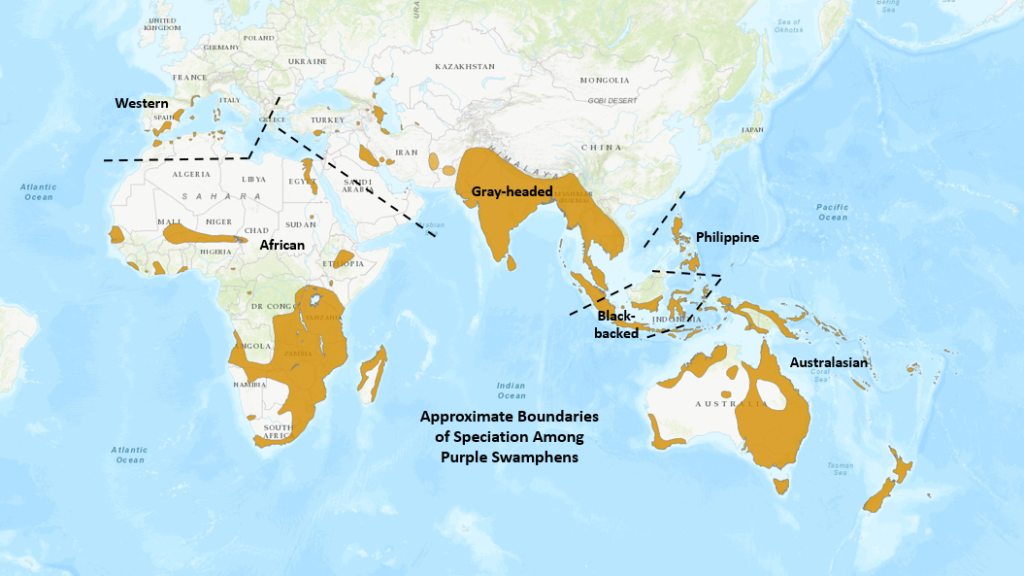
Approximate distribution of the Gray-headed Swamphen in southern Asia. © BirdLife International 2019
In southwestern Asia, resident in scattered lowland areas along the Black Sea (west to the Kizilirmak Delta of Turkey) the Mediterranean (west to Antalya, Turkey), and the Caspian (mainly Azerbaijan and adjacent parts of Iran), and south through the Tigris and Euphrates River bottomlands to the coastal lowlands around the Persian Gulf (where it is increasing in managed waterbodies and wetlands).
In the subcontinent, it appears to be present nearly throughout, wherever suitable habitat exists, from lower Himalayan valleys south to Sri Lanka and from northern and central Pakistan to Myanmar.
In southeastern Asia, generally distributed from Yunnan south to the tip of the Malay Peninsula and northern Sumatra, and east to Hainan Island and coastal Guangdong (at least to Shantou), China. An occasional vagrant, or potential colonist, east to Fujian and Taiwan.
An introduced population is well-established and expanding in Florida. Apparently released by accident through the destruction of an enclosure by Hurricane Andrew in 1992, this population quickly began breeding around the Pembroke Pines neighborhood of Broward County. Concerted eradication efforts failed, and the population has spread north at least to Lake Apopka (by 2018). Eventual colonization outside Florida seems likely. Wanderers from this population have been found north to South Carolina and on Bermuda.
Identification
A large, long-legged gallinule clad predominantly in shades of blue that span the spectrum from turquoise to indigo and violet—but its coloration and pattern vary dramatically among and within populations.
Heavy triangular bill and ridged or horned triangular forehead shield can be multiple shades of red, from pale-pink to scarlet to brownish or blackish.
Legs are pink with dark joints: knees, wrists, knuckles.
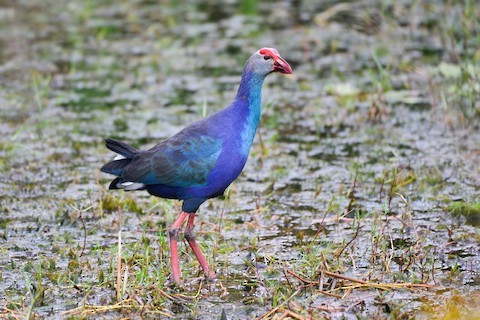
Gray-headed Swamphen showing typical plumage: mostly purplish and turquoise, becoming gray on the head. (Batu Kawan, Penang, Malaysia; February 18, 2020.) © Harn Sheng Khor
Across most of its range, most individuals show a consistent pattern, which can be either vivid or dull: shades of turquoise on the back, wings, throat and chest; sapphire-blue or purplish from the nape down to the mantle and continuously down along the sides of the chest to the belly; and pale, grayish (or even whitish) on the sides of the head—often extending up onto the crown and down the sides of the neck.
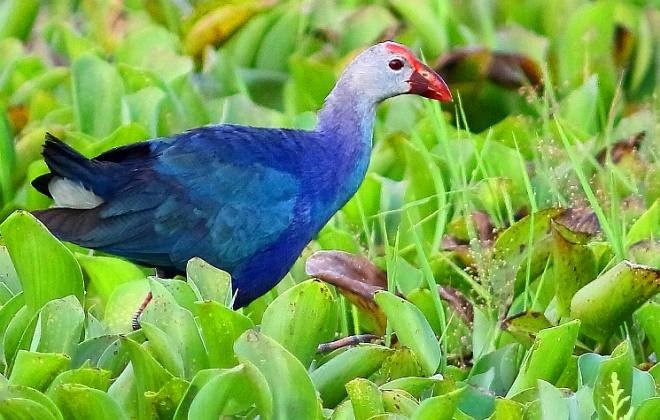
Gray-headed Swamphen showing typical but especially vivid plumage: mostly purplish and turquoise, with a whitish-gray head. (Yala National Park, Sri Lanka; March 6, 2020.) © Prosenjit Singha Deo
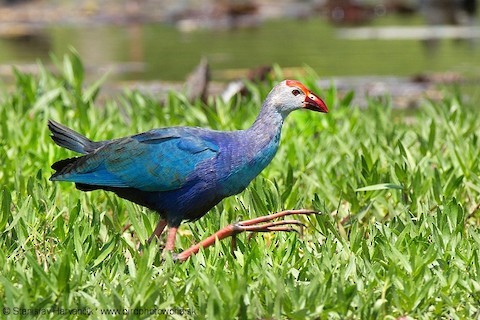
Gray-headed Swamphen showing typical but vivid plumage: mostly purplish and turquoise, with a whitish-gray head and neck. (Little Andaman Island, India; February 20, 2019.) © Stanislav Harvančík
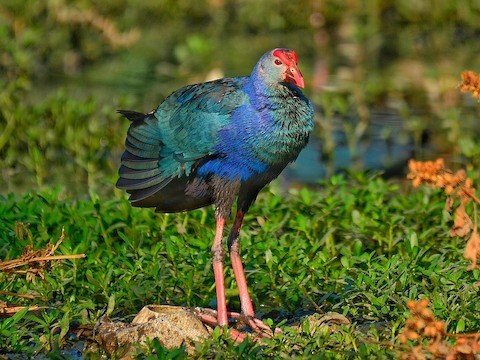
Gray-headed Swamphen showing typical plumage: mostly turquoise and sapphire, becoming grayish on the head. (Krishnampathi Lake, Seeranaickenpalayam, Coimbatore, Tamil Nadu, India; March 3, 2018.) © Renuka Vijayaraghavan

Gray-headed Swamphen, a typically patterned but pale individual with a whitish-gray head. (Thale Noi Wildlife Refuge, Phatthalung, Thailand; November 24, 2009.) © Christophe Gouraud

Gray-headed Swamphen, a typically patterned but pale individual with a whitish-gray head and a vividly shiny red bill and frontal shield. (Markham Park, Sunrise, Florida; February 6, 2016.) © Jay Keller
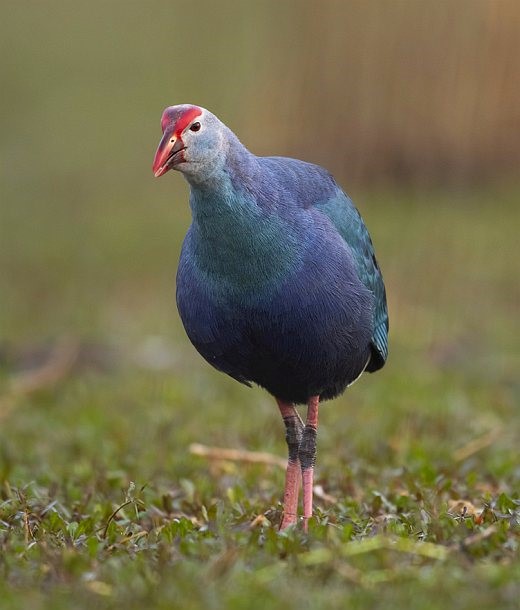
Gray-headed Swamphen showing typical plumage: mostly purplish and turquoise, becoming gray on the head. (Head Marala, Sialkot, Punjab, Pakistan; February 9, 2019.) © Tahir Abbas

Gray-headed Swamphen, a typically patterned but pale individual with a whitish-gray head. (Mannar, Sri Lanka; January 24, 2016.) © Wasantha P. Dissanayake

Gray-headed Swamphen showing typical but especially vivid plumage: mostly purplish and turquoise, with a whitish-gray head. (Little Andaman Island, India; February 21, 2019.) © Stanislav Harvančík
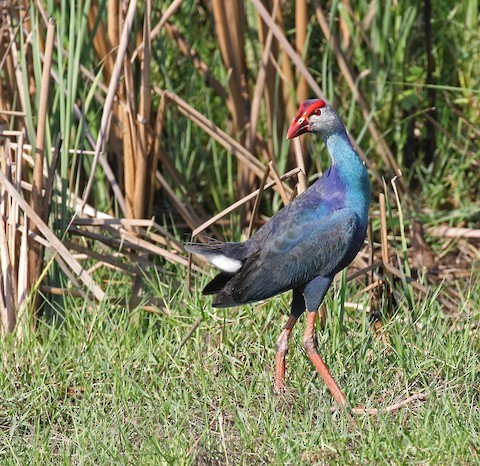
Gray-headed Swamphen showing typical plumage: mostly purplish and turquoise, becoming gray on the head. (Mukim, Penang, Malaysia; May 13, 2019.) © Dave Bakewell
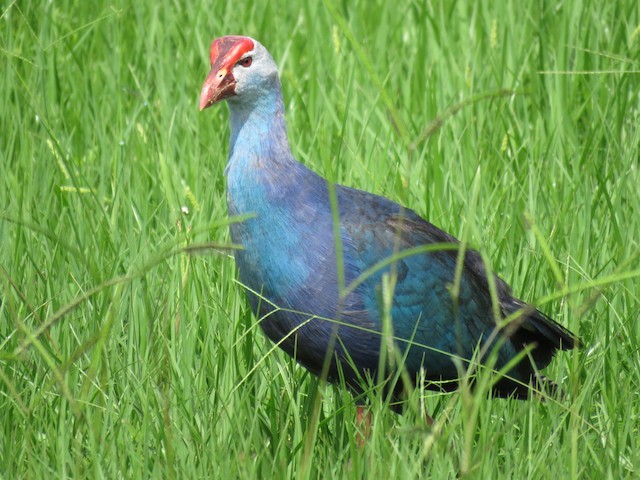
Gray-headed Swamphen showing typical plumage: mostly purplish and turquoise, becoming gray on the head. (Green Cay Wetlands, Palm Beach County, Florida; June 12, 2018.) © Phil Lehman

Gray-headed Swamphen, a typically patterned but exceedingly pale individual with a whitish-gray head. (Nong Bong Kai Wildlife Refuge, Chiang Rai, Thailand; February 20, 2019.) © Elizabeth Skakoon
Most populations, especially in Southeast Asia, include many color-variants. Most of these are darker overall, and the difference is usually noticeable on the head, which is typically blue instead of grayish (but rarely if ever black). Many of these individuals lack the turquoise tones on the wings and back—where some are extensively black instead.
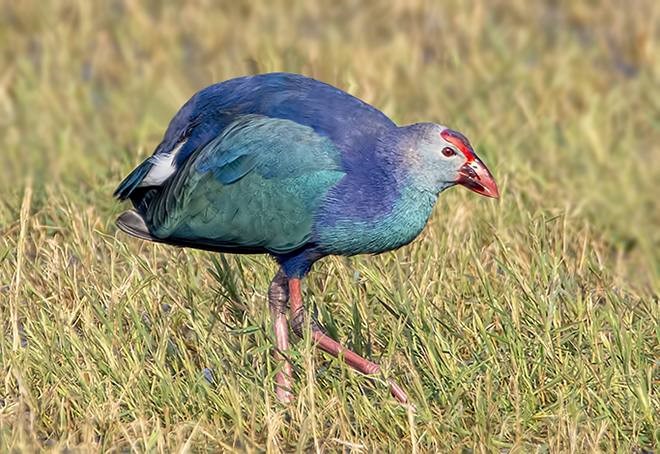
Gray-headed Swamphen, turquoise and lavender, with a gary head. (Gokuleshwar Lake, Alibag, Raigad, Maharashtra, India; January 19, 2020.) © Tushar Bhagwat
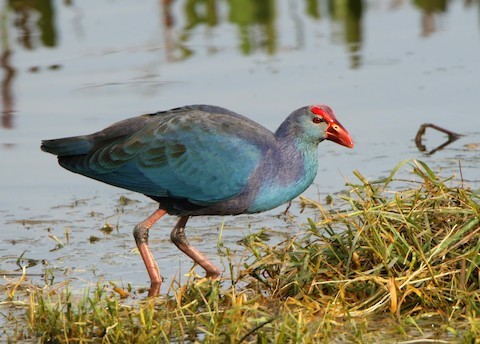
Gray-headed Swamphen, a pale individual with lavender and azure head. (Green Cay Wetlands, Palm Beach County, Florida; January 1, 2018.) © Thomas Smith
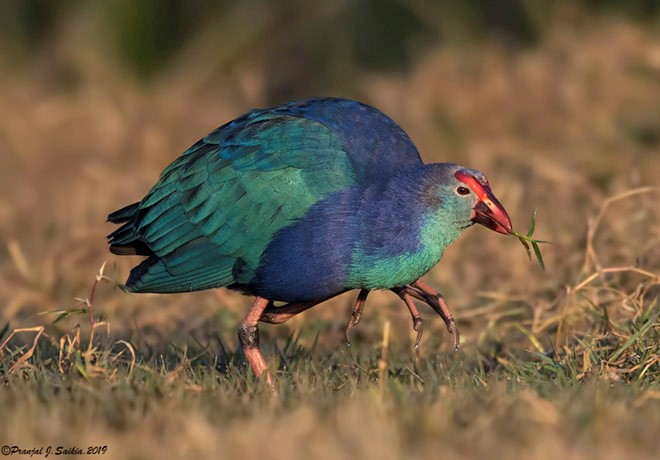
Gray-headed Swamphen, turquoise and lavender, including the head. (Jodhpur, Rajasthan, India; December 29, 2019.) © Pranjal J. Saikia

Gray-headed Swamphen, a dark individual with a purple and blue (not gray) head. (Khateshwar Tank, Yavatmal, Maharashtra, India; April 29, 2013.) © Jayant Atrey

Gray-headed Swamphen, a dark individual with a purple and blue (not gray) head. (Maguri Beel, Assam, India; December 22, 2011.) © Ranjan Kumar Das

Gray-headed Swamphen with all-purple upperparts. (Batu Kawan, Penang, Malaysia; February 25, 2020.) © Harn Sheng Khor
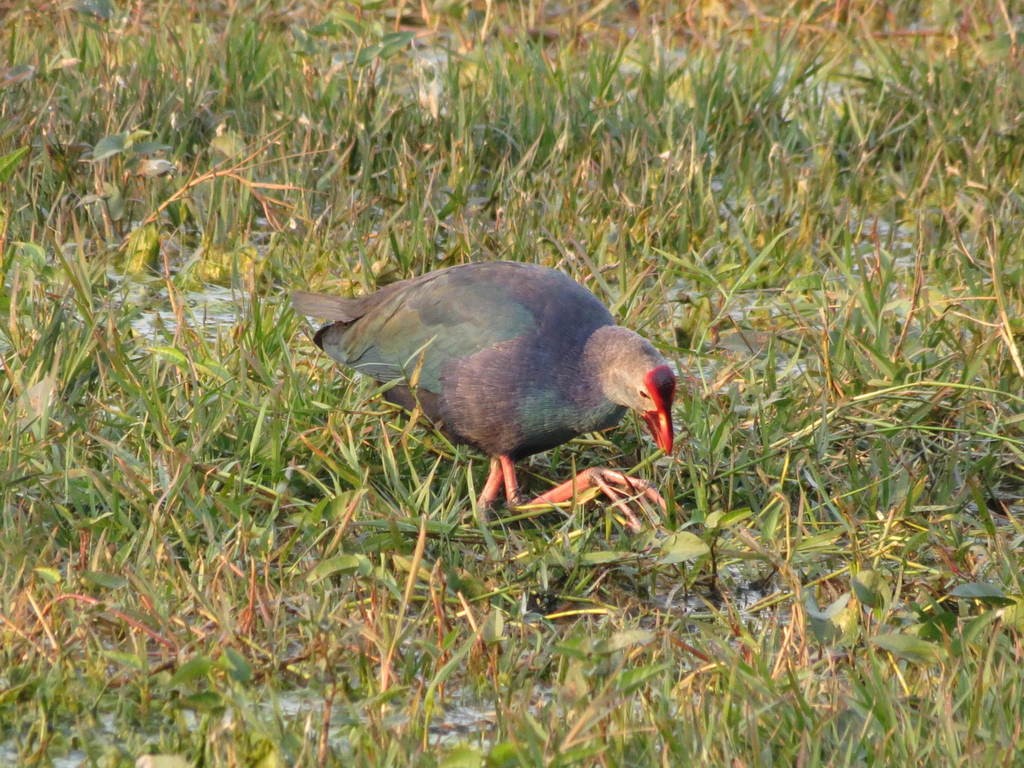
Gray-headed Swamphen, a pale individual with muted, pastel coloration. (Keoladeo National Park, Bharatpur, Rajasthan, India; December 19, 2016.) © makarandsaraf

Gray-headed Swamphen, a pale individual with lavender and azure (not gray) head. (Delapeer Talaab, Bareilly, Uttar Pradesh, India; April 30, 2020.) © Kaajal Dasgupta

Gray-headed Swamphen with bluish and purplish (not gray) head. (Green Cay Wetlands, Palm Beach County, Florida; April 21, 2018.) © Douglas “BB” Watson
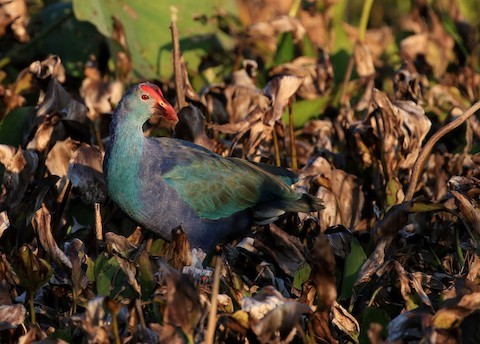
Gray-headed Swamphen, lavender and azure, including the head. (Nong Bong Kai Wildlife Refuge, Chiang Rai, Thailand; December 10, 2019.) © Patrick Monney
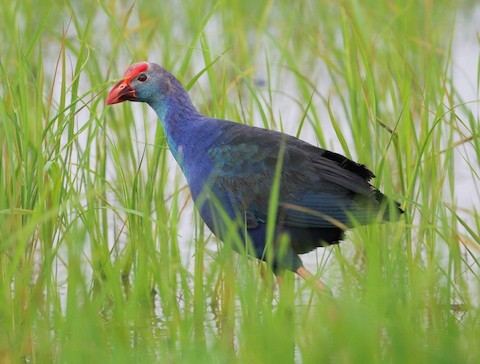
Gray-headed Swamphen with bluish and purplish (not gray) head. (Batang Tiga, Melaka, Malaysia; June 15, 2018.) © Neoh Hor Kee

Gray-headed Swamphen with purple head. (Van Long Nature Reserve, Ninh Binh, Vietnam; January 19, 2020.) © Scott Baker

Gray-headed Swamphen with all-purple upperparts. (Changaram Wetlands, Alappuzha, Kerala, India; February 25, 2018.) © Mathew Thekkethala
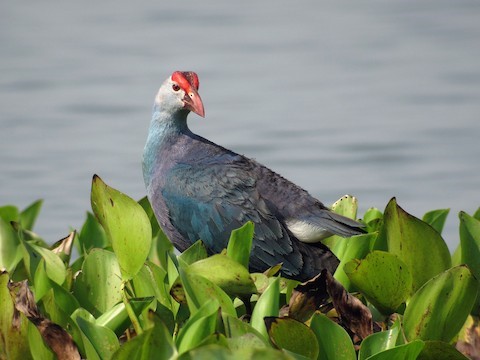
Gray-headed Swamphen, showing largely purplish upperparts. (Nong Bong Kai Wildlife Refuge, Chiang Rai, Thailand; February 28, 2013.) © Michael Schmitz

Gray-headed Swamphen, a pale individual with muted, pastel coloration. (Al Jahra Pools Natural Reserve, Kuwait; April 15, 2017.) © Paul Chapman
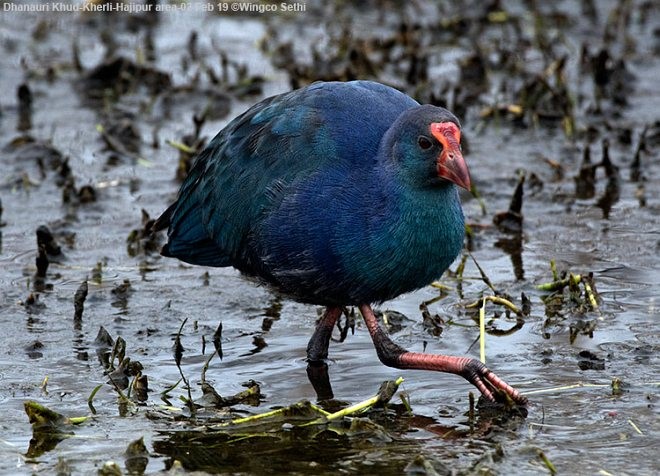
Gray-headed Swamphen, a richly blue-toned individual. (Dhanauri Wetlands, Greater Noida, Uttar Pradesh, India; February 2, 2019.) © Vijay Kumar Sethi

Gray-headed Swamphen, bright blue—perhaps an artifact of the photography. (Goa, India; April 22, 2011.) © João Ponces de Carvalho

Gray-headed Swamphen. (Nong Bong Kai Wildlife Refuge, Chiang Rai, Thailand; January 2, 2018.) © Ayuwat Jearwattanakanok

Gray-headed Swamphen, showing typical predominantly turquoise and violet plumage. (Delapeer Talaab, Bareilly, Uttar Pradesh, India; April 30, 2020.) © Kaajal Dasgupta

Gray-headed Swamphen with gray head, lavender underparts, and mostly blackish upperparts—a common color pattern in Vietnam. (Lak Lake, Vietnam; March 5, 2018.) © Lars Petersson
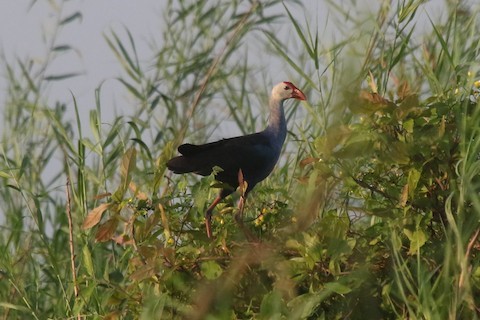
Gray-headed Swamphen, with gray head and blackish back—a common color pattern in Cambodia. (Phnom Krom, Cambodia; December 24, 2019.) © Fabio Olmos
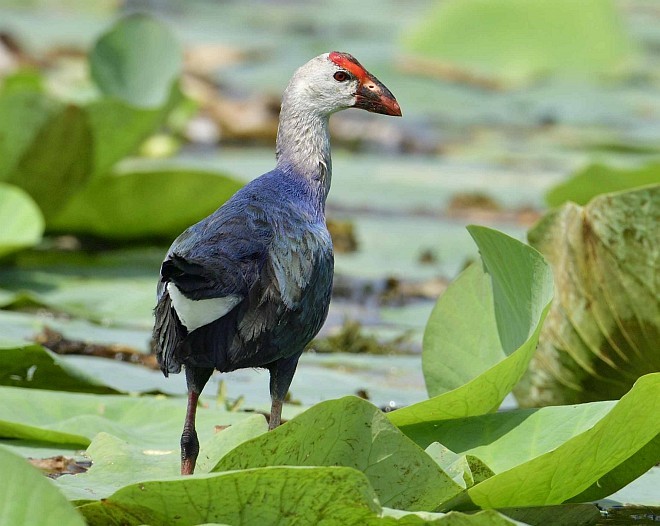
Gray-headed Swamphen with typical blue body, whitish-gray head, and blackish bill. (Lake Debarawewa, Tissamaharama, Sri Lanka; January 28, 2017.) © Wasantha P. Dissanayake
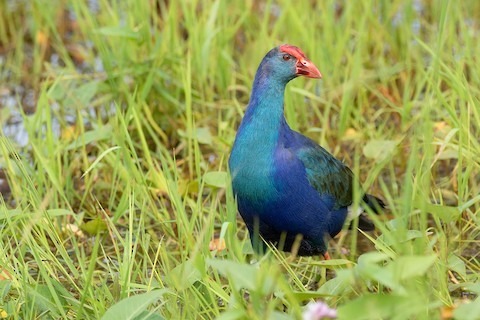
Gray-headed Swamphen with vivid turquoise head. (Nong Bong Kai Wildlife Refuge, Chiang Rai, Thailand; January 2, 2018.) © Ayuwat Jearwattanakanok
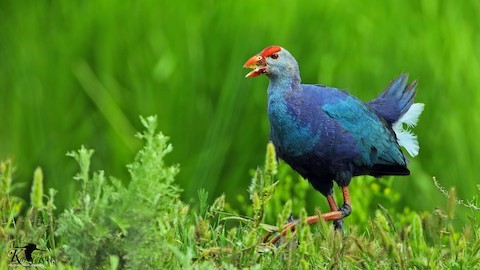
Gray-headed Swamphen, P. p. seistanicus, with azure head. (Kizilirmak Delta, Samsun, Turkey; June 15, 2011.) © Prof. Dr. Ahmet Karatash

Gray-headed Swamphen, P. p. seistanicus, showing atypically dark greenish-blue head and neck—resembling African Swamphen, but with the dark “knees” of Gray-headed. (Hur-Al Azeem, Khuzestan, Iran; July 2, 2020.) © Mehdi Dorostkar
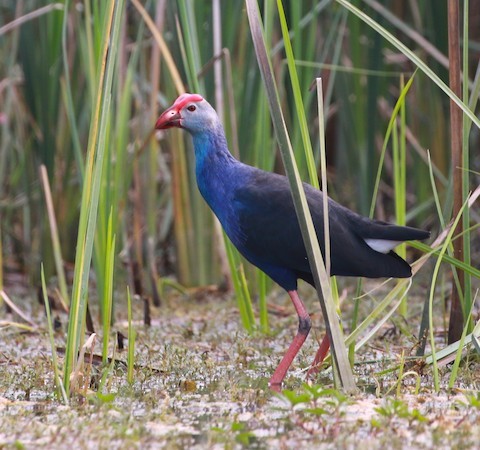
Gray-headed Swamphen, with gray head and blackish back—a common color pattern in Vietnam. (Van Long Nature Reserve, Ninh Binh, Vietnam; December 2, 2016.) © David Stejskal
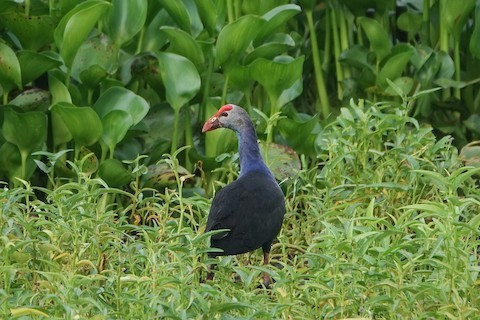
Gray-headed Swamphen, with gray head and blackish back—a common color pattern in Cambodia. (Phnom Penh, Cambodia; May 31, 2020.) © Colin Poole
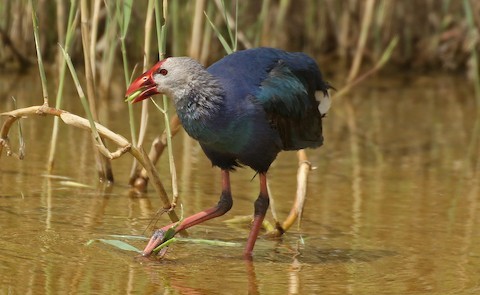
Gray-headed Swamphen with typical blue body and whitish-gray head. (Al Jahra Pools Natural Reserve, Kuwait; April 8, 2017.) © Paul Chapman

Gray-headed Swamphen, showing typical coloration with exceedingly pale whitish-gray head. (Little Andaman Island, India; February 27, 2019.) © Stanislav Harvančík
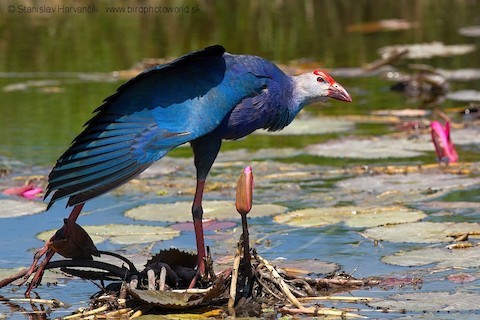
Gray-headed Swamphen, showing vividly blue spread wing. (Little Andaman Island, India; February 21, 2019.) © Stanislav Harvančík

Gray-headed Swamphen, appearing mostly turquoise throughout, including the spread wing. (Dhanauri Wetlands, Uttar Pradesh, India; March 10, 2019.) © Nitin Chandra
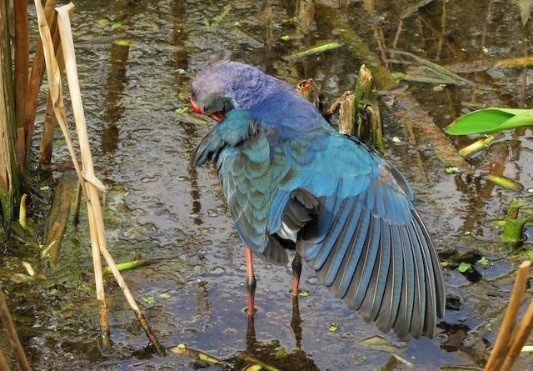
Gray-headed Swamphen, with lavender head and turquoise wing. (Green Cay Wetlands, Palm Beach County, Florida; February 13, 2018.) © Susan Young

Gray-headed Swamphen, showing mostly dark-gray underwing with pale turquoise wing-lining. (Mukim, Penang, Malaysia; May 7, 2019.) © Dave Bakewell
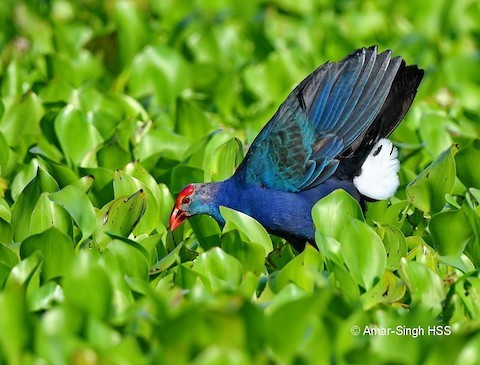
Gray-headed Swamphen, with rich blue coloration, showing turquoise and black on wings. (Tambun, Ipoh, Perak, Malaysia; January 13, 2020.) © Amar-Singh HSS
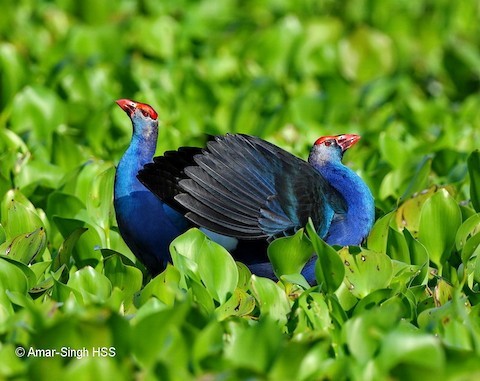
Gray-headed Swamphens, courting, showing mostly black on spread wings. (Tambun, Ipoh, Perak, Malaysia; January 13, 2020.) © Amar-Singh HSS
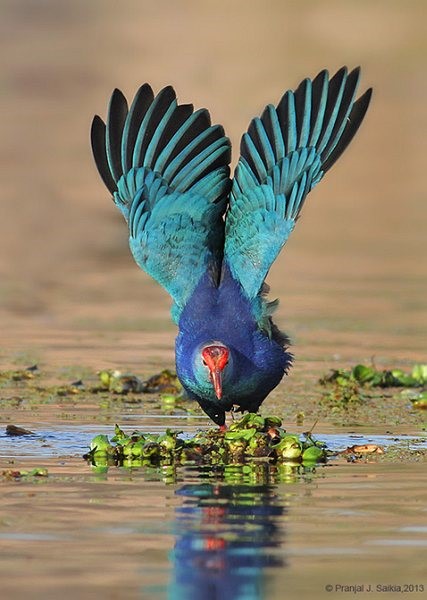
Gray-headed Swamphen, showing brilliant turquoise wings. (Jodhpur, Rajasthan, India; February 6, 2013.) © Pranjal J. Saikia
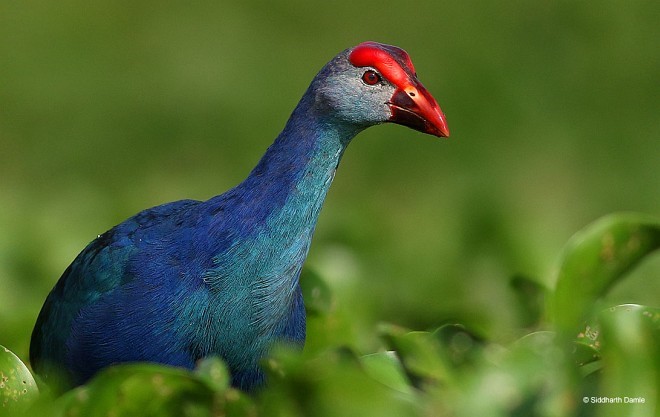
Gray-headed Swamphen, showing vivid, swollen scarlet brow ridges on frontal shield. (Pune, Maharashtra, India; June 7, 2015.) © Siddharth Damle
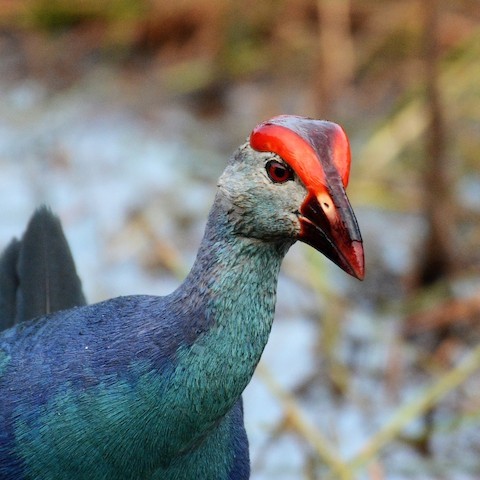
Gray-headed Swamphen, showing vivid, swollen scarlet brow ridges on frontal shield. (Sri Jayawardenepura Kotte, Sri Lanka; January 13, 2019.) © Gerhard Tauscher
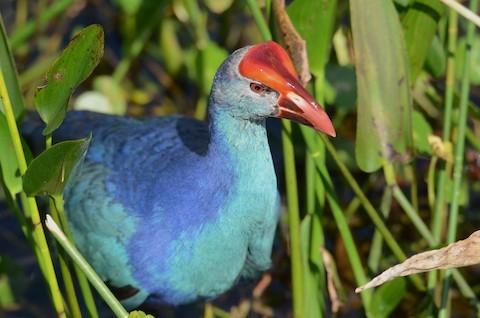
Gray-headed Swamphen. (Wakodahatchee Wetlands, Palm Beach County, Florida; February 17, 2019.) © Josephine Kalbfleisch
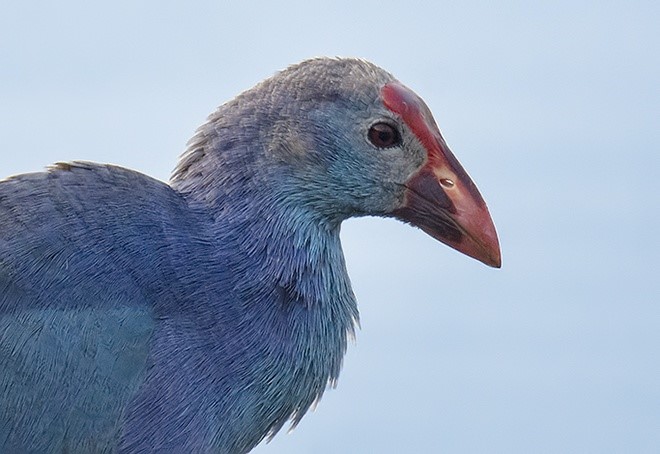
Gray-headed Swamphen. (Alibag, Raigad, Maharashtra, India; November 18, 2018.) © Tushar Bhagwat

Gray-headed Swamphen with blotchy coloration on bill and frontal shield. (Alibag, Raigad, Maharashtra, India; December 3, 2018.) © Tushar Bhagwat
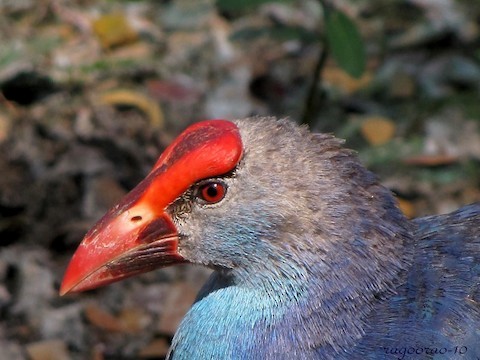
Gray-headed Swamphen, showing vivid, swollen scarlet brow ridges on frontal shield. (Mysore, Karnataka, India; January 27, 2010.) © Ragoo Rao

Gray-headed Swamphen, close view of leg showing dark joints. (Bhuj, Kutch, Gujarat, India; July 4, 2018.) © Jaysukh Parekh-Suman

Gray-headed Swamphen, feeding chick. (Little Andaman Island, India; February 21, 2019.) © Stanislav Harvančík
Immatures generally show a muted version of the adult color pattern, but usually much duller and grayer.
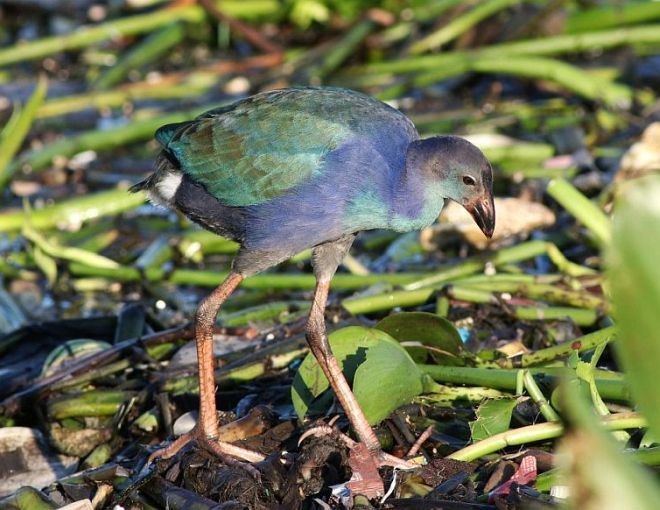
Gray-headed Swamphen, immature. (Delapeer Talaab, Bareilly, Uttar Pradesh, India; April 30, 2020.) © Kaajal Dasgupta

Gray-headed Swamphen, adult and fledgling. (Bhuj, Kutch, Gujarat, India; July 10, 2018.) © Jaysukh Parekh-Suman

Gray-headed Swamphen, fledgling. (Al Jahra Pools Natural Reserve, Kuwait; October 13, 2014.) © Omar Alshaheen
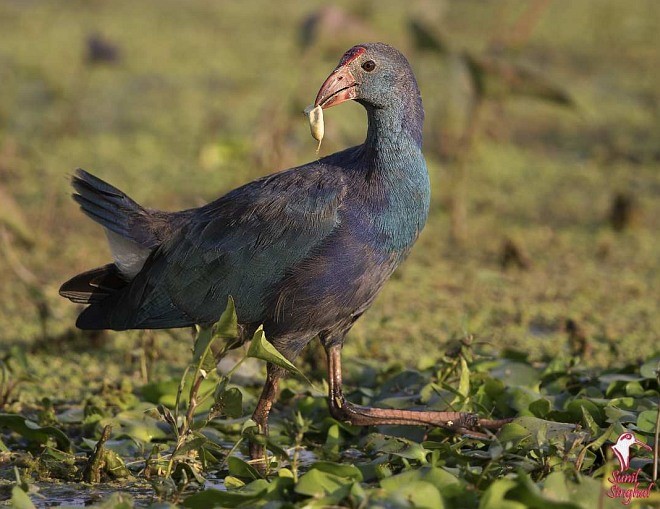
Gray-headed Swamphen, subadult. (Ummedganj Wetland, Kota, Rajasthan, India; January 8, 2016.) © Sunil Singhal
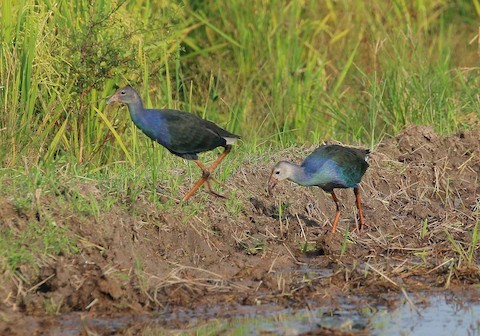
Gray-headed Swamphen, juveniles. (Batang Tiga, Melaka, Malaysia; September 2, 2017.) © Neoh Hor Kee
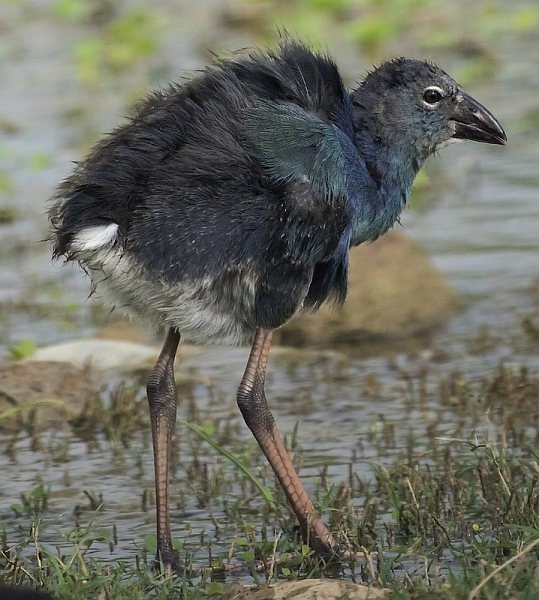
Gray-headed Swamphen, fledgling. (Bhuj, Kutch, Gujarat, India; July 2, 2018.) © Jaysukh Parekh-Suman
Voice. Gives a wide variety of vocalizations, including harsh, high-pitched, ternlike trills: Softer, squeaky trills: And wheezy moans:
Cf. Black-backed Swamphen. Gray-headed and Black-backed Swamphens apparently overlap to some extent in parts of Indonesia and Malaysia, although identification criteria are not fully understood, and the status of the two forms as fully separate species (rather than a spectrum of related populations or diverging or merging forms) remains unsettled. Much of the confusion apparently originates from underappreciation of the wide variation inherent within the Gray-headed Swamphen.

Gray-headed Swamphen with a black back—blacker than Black-backed. (Lak Lake, Vietnam; March 5, 2018.) © Lars Petersson

Gray-headed Swamphen, a dark individual with a blue-and-purple head. (Maguri Beel, Assam, India; December 22, 2011.) © Ranjan Kumar Das

Gray-headed Swamphen, a pale individual with a whitish-gray head. (Mannar, Sri Lanka; January 24, 2016.) © Wasantha P. Dissanayake

Black-backed Swamphen, P. indicus, showing its typical plumage, which is approximately intermediate between Gray-headed and Australasian. (Muara Angke, Jakarta, Java, Indonesia; April 22, 2019.) © Lars Petersson
The most conspicuous difference between Gray-headed and other swamphens is head color—hence the name. However, a large portion of individuals within Gray-headed populations have dark-blue or purple or blackish heads (proof that names are not destinies). This variability has been most amply reported in Southeast Asia, where the dividing line between Gray-headed and Black-backed Swamphens is unclear, but a similar degree of variability seems pervasive across Gray-headed’s large range.
In comparing the many plumage variations, what seems most distinctive about Black-backed is its head color: mostly black. This is potentially diagnostic, although a few Gray-headed approach the same coloration. Perhaps a slight naming adjustment, to Black-headed Swamphen, would facilitate identification—and thereby help to delineate the boundaries of indicus’s occurrence and help to confirm or refute its status as a separate species.
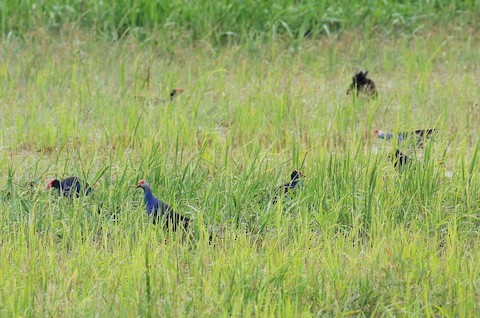
Gray-headed Swamphens with apparent Black-backed Swamphens (at far left and center). (Sungai Rambai Paddyfields, Jasin, Melaka, Malaysia; February 10, 2016.) © Neoh Hor Kee

Gray-headed Swamphens with pale and dark heads. (Taman Burung Cemara Asri, Medan, Sumatra, Indonesia; June 29, 2019.) © Bill Bacon

Gray-headed Swamphens and a possible Black-backed Swamphen at lower right. (Malim Nawar, Perak, Malaysia; February 4, 2017.) © Neoh Hor Kee
Notes
Polytypic species consisting of three or four recognized subspecies.
Traditionally considered conspecific with Western (porphyrio), African (madagascariensis), Black-backed (indicus), Philippine (pulverulentus), and Australasian (melanotus) Swamphens, collectively known as the Purple Swamphen (Porphyrio porphyrio). The emerging consensus is to include all Asian populations within Gray-headed, such that its range stretches from Turkey to China, the Malay Peninsula, and Sumatra. There is some remaining uncertainty as to whether it is truly separate from Black-backed Swamphen of Borneo, Java, southern Sumatra, Sulawesi, and Bali. (See Frontiers of Taxonomy: Parsing the Purple Swamphens.)
References
BirdLife International. 2019. Porphyrio porphyrio (amended version of 2016 assessment). The IUCN Red List of Threatened Species 2019: e.T22692792A155531172. https://dx.doi.org/10.2305/IUCN.UK.2016-3.RLTS.T22692792A155531172.en. (Accessed September 23, 2020.)
Brazil, M. 2009. Birds of East Asia. Princeton University Press.
eBird. 2020. eBird: An online database of bird distribution and abundance. Cornell Lab of Ornithology, Ithaca, N.Y. http://www.ebird.org. (Accessed September 23, 2020.)
García-R., J.C., and S.A. Trewick. 2015. Dispersal and speciation in purple swamphens (Rallidae: Porphyrio). Auk 132:140-155.
Ripley, S.D. 1977. Rails of the World: A Monograph of the Family Rallidae. David R. Godine, Publisher, Boston.
Robson, C. 2002. Birds of Thailand. Princeton University Press.
Taylor, B., and B. van Perlo. 1998. Rails: A Guide to the Rails, Crakes, Gallinules, and Coots of the World. Yale University Press.
Xeno-Canto. 2020. Grey-headed Swamphen – Porphyrio poliocephalus. https://www.xeno-canto.org/species/Porphyrio-poliocephalus. (Accessed September 23, 2020.)
